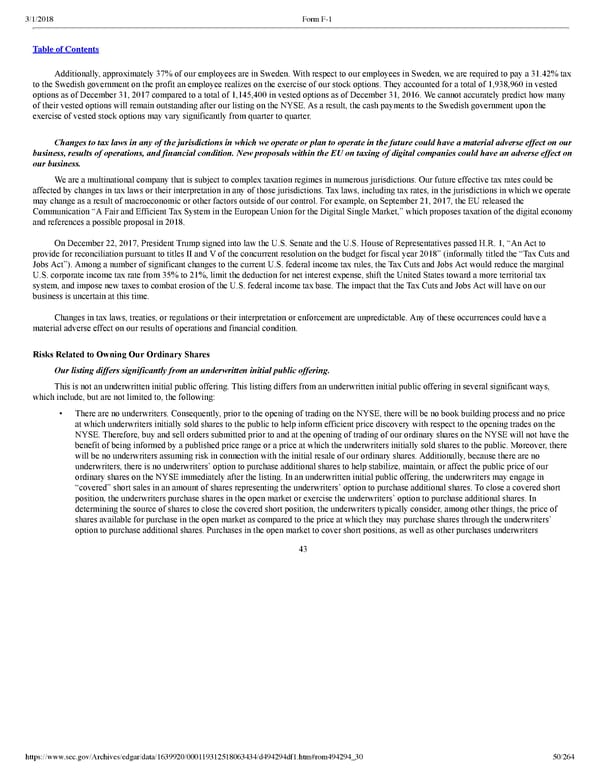50/264 Additionally, approximately 37% of our employees are in Sweden. With respect to our employees in Sweden, we are required to pay a 31.42% tax to the Swedish government on the profit an employee realizes on the exercise of our stock options. They accounted for a total of 1,938,960 in vested options as of December 31, 2017 compared to a total of 1,145,400 in vested options as of December 31, 2016. We cannot accurately predict how many of their vested options will remain outstanding after our listing on the NYSE. As a result, the cash payments to the Swedish government upon the exercise of vested stock options may vary significantly from quarter to quarter. Changes to tax laws in any of the jurisdictions in which we operate or plan to operate in the future could have a material adverse effect on our business, results of operations, and financial condition. New proposals within the EU on taxing of digital companies could have an adverse effect on our business. We are a multinational company that is subject to complex taxation regimes in numerous jurisdictions. Our future effective tax rates could be affected by changes in tax laws or their interpretation in any of those jurisdictions. Tax laws, including tax rates, in the jurisdictions in which we operate may change as a result of macroeconomic or other factors outside of our control. For example, on September 21, 2017, the EU released the Communication “A Fair and Efficient Tax System in the European Union for the Digital Single Market,” which proposes taxation of the digital economy and references a possible proposal in 2018. On December 22, 2017, President Trump signed into law the U.S. Senate and the U.S. House of Representatives passed H.R. 1, “An Act to provide for reconciliation pursuant to titles II and V of the concurrent resolution on the budget for fiscal year 2018” (informally titled the “Tax Cuts and Jobs Act”). Among a number of significant changes to the current U.S. federal income tax rules, the Tax Cuts and Jobs Act would reduce the marginal U.S. corporate income tax rate from 35% to 21%, limit the deduction for net interest expense, shift the United States toward a more territorial tax system, and impose new taxes to combat erosion of the U.S. federal income tax base. The impact that the Tax Cuts and Jobs Act will have on our business is uncertain at this time. Changes in tax laws, treaties, or regulations or their interpretation or enforcement are unpredictable. Any of these occurrences could have a material adverse effect on our results of operations and financial condition. Risks Related to Owning Our Ordinary Shares Our listing differs significantly from an underwritten initial public offering. This is not an underwritten initial public offering. This listing differs from an underwritten initial public offering in several significant ways, which include, but are not limited to, the following: • There are no underwriters. Consequently, prior to the opening of trading on the NYSE, there will be no book building process and no price at which underwriters initially sold shares to the public to help inform efficient price discovery with respect to the opening trades on the NYSE. Therefore, buy and sell orders submitted prior to and at the opening of trading of our ordinary shares on the NYSE will not have the benefit of being informed by a published price range or a price at which the underwriters initially sold shares to the public. Moreover, there will be no underwriters assuming risk in connection with the initial resale of our ordinary shares. Additionally, because there are no underwriters, there is no underwriters’ option to purchase additional shares to help stabilize, maintain, or affect the public price of our ordinary shares on the NYSE immediately after the listing. In an underwritten initial public offering, the underwriters may engage in “covered” short sales in an amount of shares representing the underwriters’ option to purchase additional shares. To close a covered short position, the underwriters purchase shares in the open market or exercise the underwriters’ option to purchase additional shares. In determining the source of shares to close the covered short position, the underwriters typically consider, among other things, the price of shares available for purchase in the open market as compared to the price at which they may purchase shares through the underwriters’ option to purchase additional shares. Purchases in the open market to cover short positions, as well as other purchases underwriters 43
 Spotify F1 | Interactive Prospectus Page 49 Page 51
Spotify F1 | Interactive Prospectus Page 49 Page 51